|

Birding Africa: how to bird the continent strategically
A great many birders visit Africa once and then realize they have seen only the tip of the iceberg. Even a single African country can need multiple visits. But, what are the must-visit countries? What makes Africa unique and where the birds, mammals and other sights best found. Chris Lotz of Birding Ecotours suggest the most strategic ways of covering Africa properly, starting with the priority countries and ending with less important ones that only true African addicts will need to visit. Certainly, if you're a serious world lister, you'll have to spend a great many months here.
|
|
|
Introduction:
When I lived in Wyoming, fellow birders and wildlife enthusiasts were often amazed that I was from Africa. To my American colleagues, it was a continent they dreamed about visiting, but most of them resigned themselves to the incorrect notion that Africa was simply too difficult to visit. Unlike the neo-tropics, I found that many American birders (wrongly) considered Africa just too far away and too "dark" a continent to ever seriously consider visiting. It is "the great unknown" to many people, despite being the world's richest place for mammals, and one of the most diverse continents for birds. Africa is a big continent. At nearly four times the size of the Lower 48, to say that Africa presents a humungous area to explore is an understatement! Roads over vast tracts of the continent are almost non-existent, or at very least poor and full of potholes (some of which can swallow a car!), so where does one start? The answer is probably South Africa or Namibia, where there are truly excellent networks of paved roads and comfortable accommodations. But, it is actually a trivial matter to safely explore a plethora of African countries thanks to birding tour companies that now make even West Africa look easy.
A great many birders visit Africa once and then realize they have seen only the tip of the iceberg. Even a single African country can need multiple visits. But, what are the must-visit countries? In this feature I will just begin to answer this question, suggesting also the order in which one can sensibly bird the continent. I will start with a very broad overview of what makes Africa unique and where the birds, mammals and other sights are best found. Then I will focus on some strategic ways of covering Africa properly, starting with the priority countries and ending with less important ones that only true African addicts will need to visit. But beware, you will fall in love with this continent fast and might wish to return annually. Certainly, if you're a serious world lister, you'll have to spend a great many months here. If not, you might wish only to see a reasonable sample of the characteristic African bird families (such as the dazzlingly beautiful turacos, the bizarre mousebirds and all the others) plus of course the megafauna. Whatever your focus, you are bound to become seriously enchanted with this diverse continent.
Continental Overview:
Very roughly, Africa's big megafauna including 'the Big 5' are best seen in the drier and more open parts of the continent, from southern Africa (especially South Africa, Namibia and Botswana) through Zambia and Malawi (two of the continent's best-kept secrets), eventually to East Africa – where Tanzania and Kenya are often regarded as quintessential Africa. The planet's most famous game parks are located in this big tract of Africa -– Selous, the Serengeti, the Masai Mara, Etosha, Kruger, South Luangwa and others, even the smallest of which are at least the size of a small European country such as Belgium. Many of these game parks are not only infested with animals, but are also spectacularly rich in birds -– for example, Kruger has 500 species and most of these are in your face and very easy to see in addition to being brightly colored or spectacular -– storks, rollers, bee-eaters, barbets and other beauties. And on a month-long East African birding tour, we sometimes come amazingly close to reaching 900 bird species seen! That, in addition to all the big (and small) African mammals and the amazing atmosphere of African– villages, the sound of African drums, markets and super-friendly people – make for an unforgettable experience.
Unlike South and East Africa, much of Central and West Africa (for example Uganda, Gabon, Cameroon and Ghana) is forested, with less scope for seeing megafauna and with birds hiding more. But, these parts of Africa are nevertheless essential to visit at some stage or another, not only for some of the most diverse birding on the continent including lots of endemics such as the two fabled Picathartes species, an entire bird family endemic to West Africa, but also for Gorillas, Chimpanzees, Mandrills and other forest-dwelling great apes. With luck, you might also encounter other mammals in the African rainforests of West and Central Africa, including spectacular but rarely-seen beasts like Red River Hog and Golden Cat.

Rockrunner, copyright Dominic Rollinson, Birding Ecotours
Then there are special countries such as Ethiopia and Madagascar. These destinations are so unique that they are, simply, unlike anywhere else in the world. Ethiopia, "the Roof of Africa", with its spectacular plateaus, peaks and ruins dating to Biblical times, boasts the charismatic Simian Wolf and the second highest number of country endemics on the continent (beaten only by South Africa). And then there is Madagascar. "The Eighth Continent" is an excellent name for this huge island, largely because its birds, animals and plants are absolutely nothing like those of any of the other seven continents. Whichever way you look at it, Madagascar presents you with an "other-worldly" experience. Despite being a stone's throw from the African mainland, it's nothing at all like Africa proper! This is likely because it has been isolated for so long –- when it split away from India, it gradually drifted towards Africa and is now very close –- albeit not close enough to have shared its birds or other wildlife very much, judging by its amazing faunal and floral uniqueness. Half its bird species are endemic, and an incredible five avian families are found nowhere else either!
On a month-long East African birding tour, we sometimes come amazingly close to reaching 900 bird species seen! That, in addition to all the big (and small) African mammals and the amazing atmosphere of African– villages, the sound of African drums, markets and super-friendly people –make for an unforgettable experience.
Broad-scale Geographical Features of Africa:
Returning to the African mainland, there are some other broad-scale geographical features that need mentioning. The Sahel is a vast tract of dry savannah stretching all the way from Ghana in the west to Ethiopia in the East, and forming the boundary between the Sahara and the lush grasslands and forests further south. The Sahel has a unique birdlife and many of its species occur from Northeast Africa (where Ethiopia is a good place to see them) right across to Northwest Africa (where Ghana and northeast Cameroon are good places for them). North of the Sahel is the world's largest desert, which separates "the real Africa" from Morocco and other North African countries -– these are more Mediterranean in feel and arguably have more affinities with Spain and other European countries at least as far as their birdlife is concerned. The focus of this blog is from the Sahel southwards, i.e. sub-Saharan Africa.
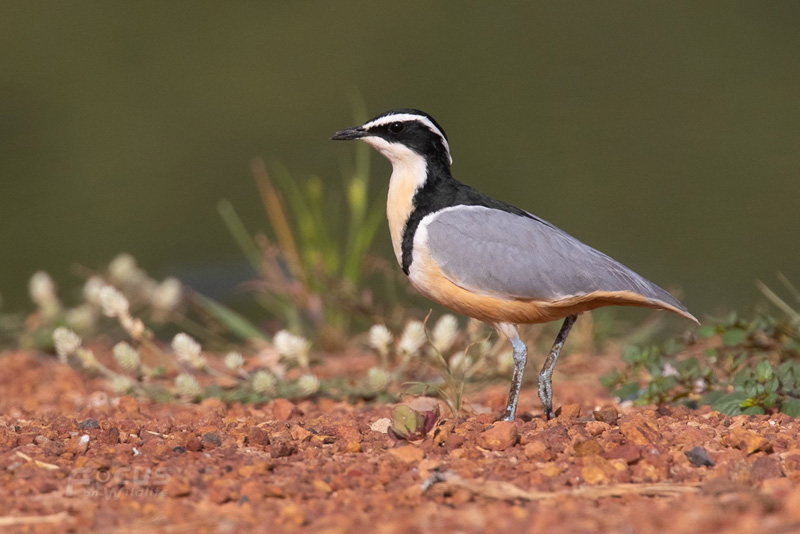
Egyptian Plover, copyright Birding Ecotours
The other major geographical feature (and major bird habitat) of Africa that I have not mentioned yet is the mountains. In countries such as Namibia, there are imposing batholiths rising straight out of the desert plains. But of even greater interest to birders is the abundance of mountains that have isolated patches of evergreen forest on them. Most of these forest-clad mountains are, again, in the relatively open, animal- and bird-rich tract encompassing southern Africa northwards through Zambia and Malawi to East Africa. A lot of these mountains are in generally fairly dry areas, but the mountains generate increased precipitation and support lush forests on their non rain-shadow slopes. A lot of these mountains have endemic, localized birds. For example, the Eastern Arc Mountains of Tanzania are where most of that country's endemic bird denizens lurk. Similarly, the Eastern Highlands of Zimbabwe and Mount Gorongosa in nearby Mozambique also have some excellent range-restricted birds. Some of these 'Afro-montane' endemics, such as Udzungwa Forest Partridge, are found on only a single mountain. Others, like Green Barbet and Green-headed Oriole inhabit just a couple of mountains. In Western Africa, Angola and Cameroon also have a lot of these forested mountains, all with fine suites of endemics. Cameroon, in fact, is one of the most amazing West African countries to bird, because it not only has all the lowland equatorial rainforest birds endemic to West Africa, but it also has a lot of Afro-montane localized birds found nowhere else but on the slopes of its mountains. Furthermore, excitingly, part of the country also reaches the Sahel where arid-adapted North African birds lurk. The range of habitats in many of these African countries is indeed part of what makes them so very rich in terms of species. Another example besides Cameroon is Tanzania, where within the space of a couple of hours, you can drive out of the arid Ngorongoro Crater with its African megafauna and dry area birds, to the dizzying heights of the crater rim, which have lush evergreen forest inhabited by localized high altitude forest birds.

Little Bee-eater, copyright Oli Reville, Birding Ecotours
Startling Diversity:
Before summarizing how to bird Africa strategically, I want to highlight just how diverse this continent is. It is famous as "THE mammal continent", but what about birds? Most ornithologists argue that South America is "THE bird continent" because of its sheer number of species. Indeed, Colombia has the highest bird species count of any country on the entire planet -1906 species! (this was the country list in 2013 but has increased due to new additions since). But, many of its species are genetically (and hence visually) rather similar – South America has humungous bird families such as antbirds, tanagers and New World flycatchers that each contain a large number of similar birds. So you'll see a great many relatively similar birds. Now, consider an area the same size as Colombia in East Africa– combining Tanzania and Uganda one ends up with a surface area matching Colombia's, and one finds a bird species count of 1390. That is 73 %, which is not a bad total, since I am comparing with the world's richest bird country based on species count alone. However, the intriguing thing is that Tanzania/Uganda has 107 families, compared to only 89 in Colombia.
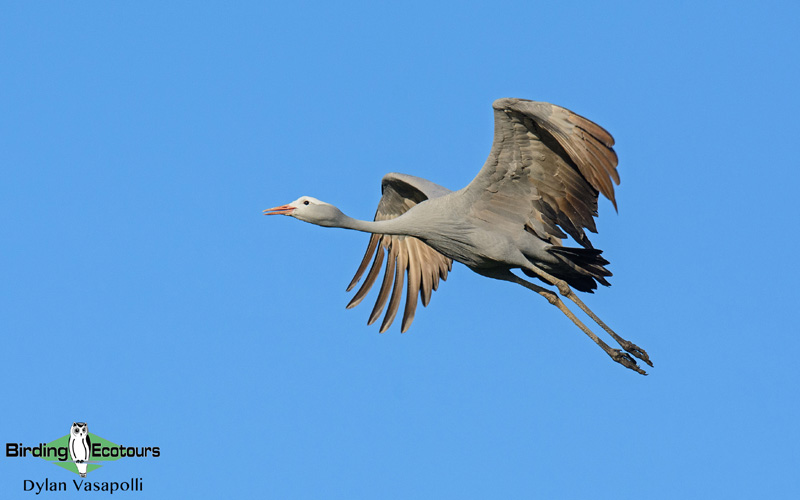
Blue Crane, copyright Dylan Vasapolli, Birding Ecotours
This means that East Africa's birds are distributed in more families than Colombia's birds – in other words, East Africa's species are more different from one another than Colombia's, on average. Thus, there is in fact an argument for Africa to actually be the most diverse bird continent, especially if you want to see as much genetic diversity as possible. Invariably, sub-Saharan Africa (whether west, south, east or north) has the highest family counts compared to similar sized regions in the other highly bird-rich parts of the globe (basically the tropical regions of Asia, Australasia and the Americas). That is part of why Africa is such a satisfying place to go birding – because the species are on average more different from each other than elsewhere, with the species distributed in a greater number of families than elsewhere. Please write to info@birdingecotours.com for an article that deals specifically with bird diversity patterns considering species, genera, families and orders, across Africa and the planet.
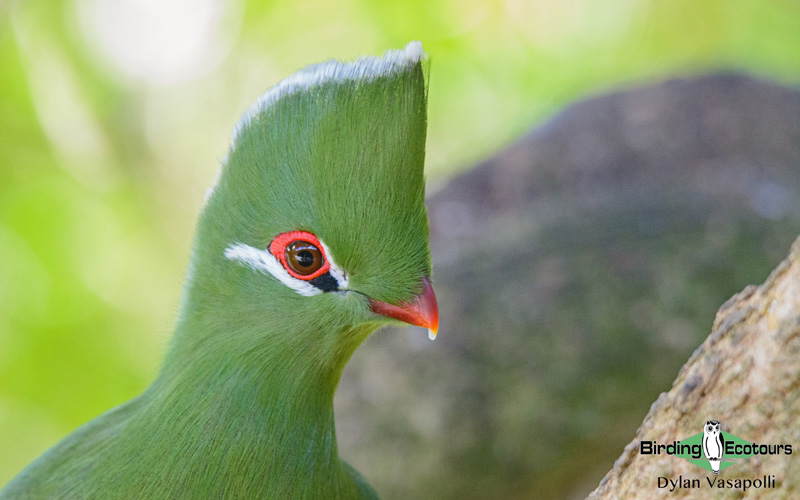
Knysna Turaco, copyright Dylan Vasapolli, Birding Ecotours
Avian Endemism in Africa:
Other parts of Africa are not always as species-diverse as East Africa, but often an even more important consideration to birders than diversity, is endemism. Madagascar has over 102 endemics, South Africa 62, Ethiopia 30 and Tanzania 20. Interestingly, Kenya has only 6 endemics, but has the highest species count of any African country. This means that it is an extremely rewarding country to visit if on your first trip to Africa. But Kenya is hardly worth birding if you have visited the neighboring countries (Uganda, Ethiopia and Tanzania), all of which have a lot more range-restricted or endemic species.
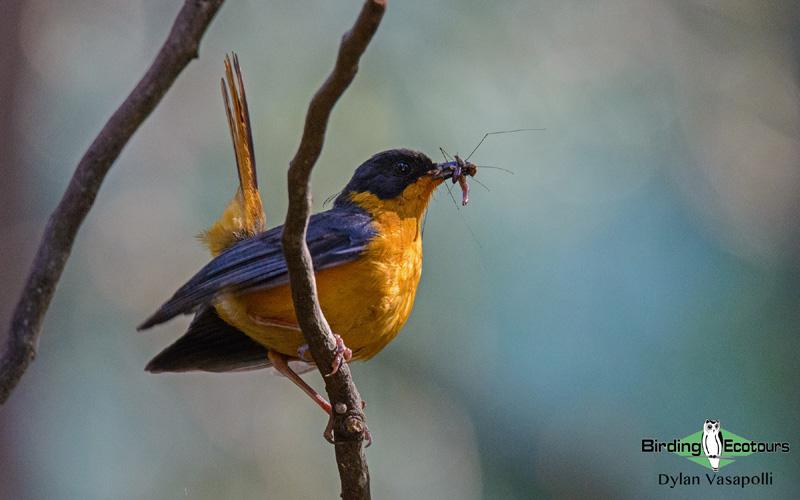
Chorister Robin-chat, copyright Dylan Vasapolli, Birding Ecotours
Some important African endemic bird areas straddle borders. For example, the Albertine (or Western) Rift has a host of endemics that can be seen in extreme south-western Uganda, neighboring Rwanda or the Democratic Republic of the Congo (DRC). Most birders seek these Albertine Rift endemics in Uganda, which is safe and easy to visit, and also hosts almost as many birds as Kenya (over 1000 species), even though its half the size, plus Shoebill, Gorillas, Chimps and spectacular sights such as the source of the Nile, Africa's greatest lake and the fabled 'Mountains of the Moon' (the spectacular Rwenzori Range). Then, another example is the bunch of endemics that straddle the border between Namibia and Angola. These include stunning species such as Bare-cheeked Babbler, Herero Chat and a host of others. Finally, south-central Africa has a lot of endemics, many of them only inhabiting Miombo woodland – an attractive dry forest type ranging from Zimbabwe and Mozambique through Zambia and Malawi to the DRC and marginally into Tanzania. Zambia is the best place to find these birds, but Malawi is also very accessible, as are some of the other south-central African countries. The article shown here discusses part of this region in more detail.
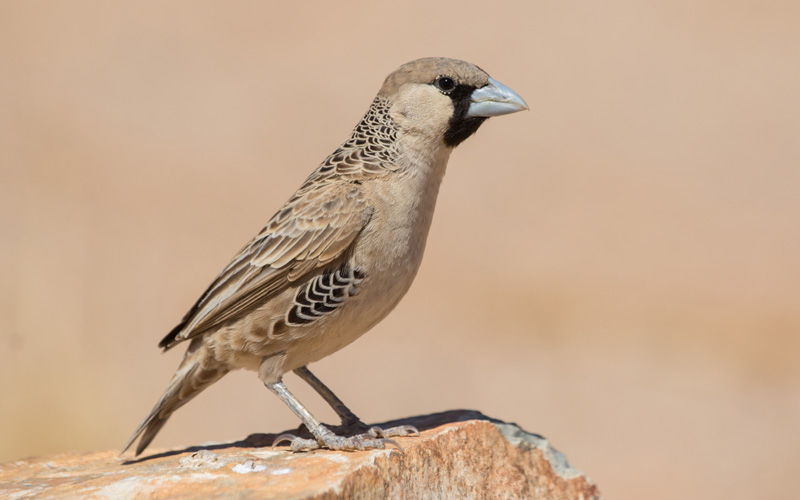
Sociable Weaver, copyright Birding Ecotours
Top 10 Places to visit in Africa:
So, where does a birder start on this massive continent? In this, the final section of my article, I suggest the first ten African countries to visit, in descending order of priority. Most first-time visitors to Africa understandably also wish to see the megafauna, so it makes sense to narrow it down to southern or East Africa. The number one country for a first time visit to Africa might well be South Africa. It has the Big 5, as well as an amazing diversity of smaller mammals. The Kruger National Park and the Zululand game reserves have considerable numbers of smaller mammal species as well. Given a 2-week birding tour starting in Durban and ending in Johannesburg, one will see all these mammals and also end up with a respectable bird list of around 400 species. Adding the Cape, one of the most scenically spectacular corners of the continent, you might add another 100-150 bird species, whales and more. South Africa is relatively inexpensive, and has a vast network of friendly and comfortable B&B's. It's easy enough to bird the country on a self-drive, but of course it's wiser to link up with a birding tour operator. For more reading about the essential parts of South Africa that need to be covered, I refer you to three separate tours, Subtropical South Africa Birding Tour: Comprehensive Eastern South Africa, Best of Cape Town and Beyond: Endemics, Seabirds and More and Western South Africa: Cape Endemics, Namaqualand Wildflowers and the Kalahari. If you have limited time and just want to see the big mammals and a ton of birds, then our Premium Kruger and Escarpment Birding and Wildlife Safari is an excellent one. South Africa is an amazingly picturesque country with lots of mountains, beautiful white sand beaches and so much more. The overall experience of being in this country is wonderful and we find that birders often return here as often as they can, even once they've seen most of the birds. It's a big country though and takes many weeks of pure birding to get to grips with the species, which is of course a good excuse to return and to have another good time in a wonderful country.

White-browed Robin-chat, copyright Dylan Vasapolli, Birding Ecotours
The alternative to starting first in South Africa is to do what we call "An Introduction to Africa", which is a week in Tanzania, as described here. In fact, if you have more than about a week, Tanzania is arguably the best country to visit second but giving it at least 2.5 weeks if possible – as detailed here. By birding Tanzania, you'll add a host of East African endemics, and also most of the 20 country endemics. You can also see your first Miombo (south-central African) endemic birds in Tanzania. And, you'll see a great many of Africa's big (and small) animals, along with some of the continent's most famous sites. These include the Great Rift Valley and its flamingo-filled lakes, the Serengeti with its relatively easy to see Big Cats & Wildebeest migration, Ngorongoro Crater and last but not least, Kilimanjaro, one of the world's most massive isolated mountains. Africa's highest mountain rises straight out of the wildlife-riddled plains below, to a dizzying 19,341 feet above sea level.
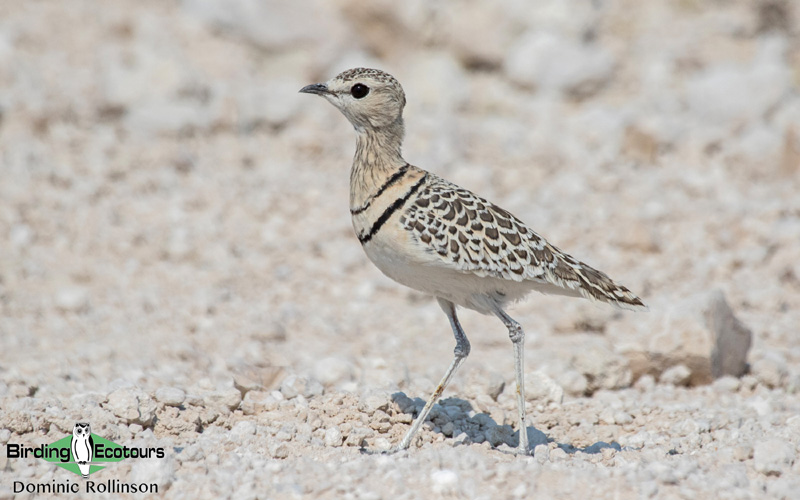
Double-banded Courser, copyright Dominic Rollinson , Birding Ecotours
Third, I'd suggest visiting Uganda. If in the long run you plan on visiting several other African countries as well, 12 days here is enough to generate the essential Ugandan birds (Shoebill, the Albertine Rift endemics, Green-breasted Pitta, etc.) plus mammals (especially Gorillas and Chimps but the country also has magnificent Colobus Monkeys and more). The ideal 12-day Ugandan birding itinerary is one shown here. Nineteen days in Uganda would certainly not be wasted, though! In this little country called 'The Pearl of Africa' you'll find the people fluent in English and even friendlier than in other parts of Africa, and you'll also see the Albertine (or Western) Rift, Bwindi Impenetrable Forest, the source of the Nile at Jinja, Africa's biggest lake (Victoria) and vast Papyrus Swamps inhabited by Shoebill, a monstrous bird placed by some authorities in its own order because it's so different from any other species on earth.
Fourth, a West African country is probably in order. Even if you've already done the first three countries mentioned above, if you now visit West Africa for the first time you'll still get literally hundreds of life-birds. West Africa is rougher than southern or eastern Africa and you'll find that accommodation is more basic – but at most birding sites you'll still get a (barely) adequate level of comfort including hot water showers – if you join an organized birding tour. Cameroon (although we have currently suspended our tours there because of safety concerns at the moment but watch this space) is arguably the best West African starter country, since you'll see the country endemics, as well as the more widespread West African rainforest species, and also many Sahelian birds. A near-comprehensive Cameroon birding itinerary is detailed here but you can split it in half if you struggle to get enough leave to do the whole country in one go. If you're a serious world birder, you'll also need to visit one of the Upper Guinea Forest countries at some stage or another in your African birding career. Ghana is probably the best one because its local guides have staked out the birds there more than elsewhere on the Bulge of Africa, and it is English-speaking and all in all rather easy to visit. It is historically rich, but you'll be sobered since the history is not pretty and is dominated by memories of the slave trade. Please refer to our tours here. Ghana is less strenuous than Cameroon and if you only ever bird a single West African country, Ghana is not a bad one to choose. The third West African country that comes most highly recommended is Gabon. It has Lowland Gorillas, Mandrills, arguably West Africa's best mammal viewing in general, and a huge diversity of birds, quite a number of which you won’t see in Cameroon or Ghana. It's a pricey country but many people who are interested in wildlife as a whole rather than specifically birds make it their top West African country to consider. Two of Africa's richest islands for endemic birds are within Gabon's offshore territory – Principe and Sao Tome. These islands have many exciting birds found nowhere else in the world. Watch this space for Gabon, including the islands.
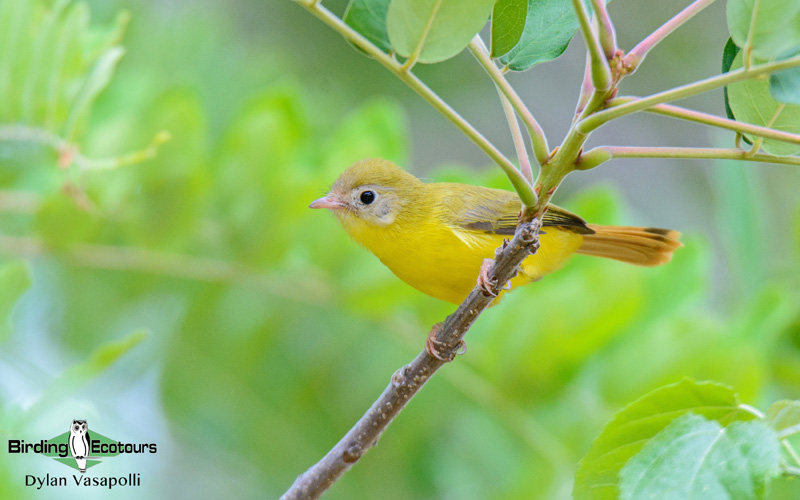
Livingstone Flycatcher, copyright Dylan Vasapolli, Birding Ecotours
Fifth must surely be Namibia, which is a must-visit African country since it is so very unique, with the world’s oldest desert including the highest sand dunes in the world, which are a spectacular red color, other massive sand dunes coming right down to the sea, rugged desert mountains along the Namibian Escarpment, desert elephants and rhinos, one of the world's greatest game parks and my personal favorite of all of Africa's parks, the vast Etosha National Park. And, last but not least, Namibia has a whole bunch of birds that are only found there or in adjacent Angola. While in Namibia, it is easy to foray briefly into Botswana to see PEL'S FISHING OWL, one of Africa's most sought-after birds, Slaty Egret, a Botswana near-endemic, and tons more, in the nearby panhandle of the Okavango Delta. And, since you're so close to one of the world's most impressive waterfalls, Victoria Falls, a 2-day foray to this site either from the Zambian or Zimbabwean side is very worthwhile and will anyway add lots of new birds to your burgeoning list. I recommend 18 days to bird Namibia/the Okavango/Victoria Falls, as detailed here. Botswana is the "Gabon" of southern Africa – expensive, not all that strategic for birds (after you've spent a couple of days there tacked onto your Namibian tour), but absolutely brilliant for those into general wildlife viewing and photography rather than just birds. A Botswana example itinerary is shown here.
Sixth, I suggest Ethiopia. Most of this country is open, so the birds are easy to see and it is not very difficult to get a bird list of 550 species in about 3 weeks. And it has a ton of endemics, many of them easy to find around Addis Ababa. One of Ethiopia's sadder claims to fame is that it is home to what is considered the next African bird to go extinct, Liben (Sidamo) Lark, which inhabits a single football-sized piece of arid grassland which is under severe pressure from cattle overgrazing especially during the horrid droughts the Horn of Africa often experiences. An entire genus could potentially go extinct since there are only two other species in Liben Lark's genus – Archer's Lark also of Ethiopia which is reputed to already be extinct, and Rudd's Lark of South Africa, which is critically endangered itself.
At this point I'd like to take a "commercial break" and call on the rich countries of the world to contribute to conservation in Africa, as resources in this, the world's poorest continent, are of course very limited and destructive techniques such as slash and burn agriculture are rife, leading to unprecedented habitat destruction. By joining birding tours, you are directly supporting conservation, in fact. The local guides and accommodation establishments used by international birding tour companies for ground logistics in all of the countries mentioned in this blog, depend on birding tourists for their livelihood, and since it is a matter of financial survival for them, they try their best to conserve the birding sites and hence ultimately the birds of Africa (as long as the foreign birders keep flocking in). Some companies, such as Birding Ecotours, also make it their policy to contribute a set percentage of their annual profits to bird conservation and local communities, in direct support of sustainable development.
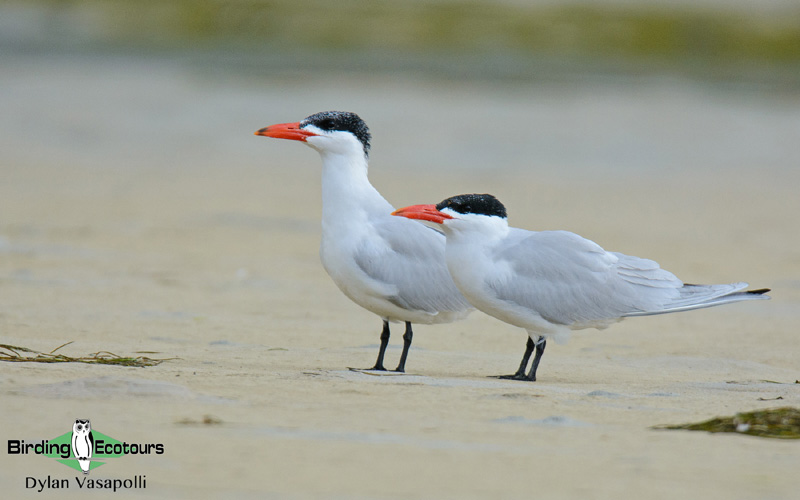
Caspian Tern, copyright Dylan Vasapolli, Birding Ecotours
Seventh is Madagascar. Actually, it could of course have been number one. It's so unique we call it "The Eighth Continent". So, in a sense, it's separate from the rest of the Africa and, quite simply, needs to be birded – and of course it is full of other wildlife such as several endemic mammal families (lemurs being the most famous and charismatic), over half the world's chameleons, and so much more. The Baobab-dotted spiny forests, the 'Stone Forest' of Tsingy, the beautiful, remote, tropical beaches and so much more adds flavor to the birding. Bizarrely, Madagascar is sometimes eerily quiet, bird-wise. It has fewer bird species and individuals than almost anywhere else, but (trust me!) this paucity of quantity is more than compensated for by incredible quality. Setting your eyes on a ground-roller, the luminous blue bill of a Helmet Vanga, a Black-and-white Ruffed Lemur or a dancing Sifaka will be an experience you will be unable to forget for the rest of your life. The tour shown here gives a good option – 14 days gives you an excellent taste of the island’s wildlife, but extensions are recommended, and you need 24-30 days to see most of the island's birds.
Eighth is a south-central African country and either Zambia or Malawi are arguably best. These countries are surprisingly poorly known but mega-rich bird-wise, also with tons of African megafauna. South-central Africa has a great many endemic birds but very few of them are restricted to any one country. Zambia is the single best country for finding the greatest number of these species, but picturesque Malawi, as well as Mozambique and Zimbabwe, are also great places for these birds. Zambia is also the second most famous country for Shoebill (after Uganda). African Pitta, another of Africa's most desirable birds, is best sought on its breeding ground in the Zambezi River catchment of Zambia, Malawi, Zimbabwe or Mozambique. Tour examples for these countries are shown for Zambia, Malawi and Zimbabwe.

Cape Rock Thrush, copyright Dylan Vasapolli, Birding Ecotours
Ninth is the Central African Republic, where Sangha Lodge has recently opened up Central Africa to birders (and Lowland Gorilla seekers). Previously, absolutely vast tracts of central Africa were inaccessible, but now this new lodge provides a safe (but fairly expensive) realistic option. Since Central Africa was almost un-birded until recently, it is not surprising that exciting avian discoveries are being made here at a rapid pace – for example, Picathartes, African Piculet and other classically West African species are being found here hundreds of miles further east than expected. Who knows, you might be part of a group discovering a bird new to science, if you choose to visit a place like this. Odzala Camp in the DRC is another amazing option to consider.
Tenth is cleaning up on the rest, and this might take you months and years! For example, Angola has many spectacular endemics especially around the beautiful Gabela Mountains. Sierra Leone is well worth doing to find the handful of Upper Guinea Forest endemics that lurk there and not in Ghana. You'll need to do Kenya for a few endemics and for some of Africa's famous sites. And, there is just so much more!
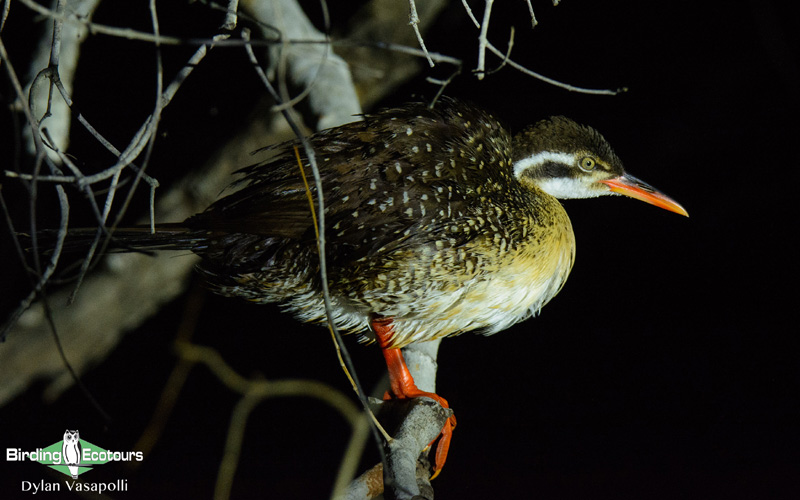
African Finfoot, copyright Dylan Vasapolli, Birding Ecotours
Africa's Top 10 Birds and where to see them:
Any Turaco species. These unbelievably colorful birds are endemic to Africa and seeing one in flight with its crimson wings is an unforgettable experience. Turacos are widespread in almost all the sub-Saharan African countries, but Uganda has Great Blue Turaco (twice the size of the "normal" Turaco) and the species I personally find most beautiful (White-crested Turaco) – although southern Africa's green Turacos come very close!
Shoebill – this monstrous dull blue stork-like bird of Papyrus Swamps is best sought in Uganda, but Zambia is also a great country for it
Either African or Green-breasted Pitta. The most reliable country for the latter is Uganda, and the former is best sought in southern Africa (especially Zimbabwe, Mozambique, Malawi or Zambia).
A Picathartes. This bizarre and charismatic African bird family is strictly West African, and Gabon, Ghana and Cameroon are all good for either of the two species. Actually, Picathartes have recently been found much further east at Sangha Lodge.
Egyptian Plover and Quail Plover – two highly desirable birds – in Cameroon you have a good chance of seeing both but other West African countries are great for them too
Helmet Vanga – vangas are a whole family endemic to Madagascar and this is the most dazzling of them all
Long-tailed Ground-roller – or any of the other 4 spectacularly colorful ground rollers, another of Madagascar's 5 endemic families
A Rockjumper, a Sugarbird and Blue Crane in South Africa
Pel's Fishing Owl which is most easily seen in Botswana – easily done by hopping across the Namibian border briefly while on a Namibian tour
Congo Peacock, Yellow-crested Helmet-shrike and other near-mythical and virtually impossible birds most birders only dream of seeing.
Essential African Bird Books:
To study where in Africa to go next (this huge field guide covers the whole of sub-Saharan Africa), do get the following book:
Please find more details about the above book and all our recommended bird field guides (and a couple of excellent apps) for individual African countries here at this blog.
|

